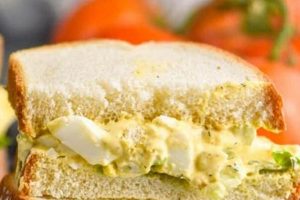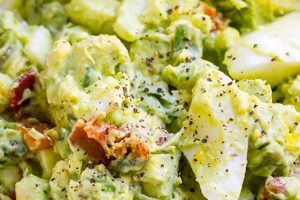A classic dish featuring cooked elbow macaroni, hard-boiled eggs, and a creamy dressing often composed of mayonnaise, mustard, vinegar, and seasonings. Variations may incorporate celery, onion, bell pepper, relish, or other vegetables. This dish is commonly served cold as a side at picnics, barbecues, and potlucks.
This simple yet satisfying dish offers a balance of carbohydrates, protein, and fats, making it a relatively complete meal option. Its adaptability allows for customization to individual preferences and dietary needs. Its popularity has endured through generations, solidifying its place as a staple in many cultures’ culinary traditions. Economical to prepare and requiring minimal cooking, it serves as an accessible and convenient food choice for various occasions.
The following sections will explore variations on this classic dish, offering insights into ingredient selection, preparation techniques, and creative serving suggestions.
Tips for Perfect Macaroni Salad
Achieving optimal flavor and texture requires attention to several key details during preparation. The following tips offer guidance for creating a superior macaroni salad experience.
Tip 1: Cook Macaroni Al Dente: Overcooked macaroni results in a mushy texture. Cook pasta until firm to the bite, then rinse under cold water to stop the cooking process and maintain the desired consistency.
Tip 2: Chill Ingredients Thoroughly: Using chilled ingredients, especially the macaroni and hard-boiled eggs, helps prevent the dressing from becoming thin and watery.
Tip 3: Season the Dressing Carefully: Balance the flavors in the dressing by incorporating a blend of tangy vinegar, savory mustard, and seasonings. Taste and adjust seasonings before adding to the macaroni mixture.
Tip 4: Use Freshly Cracked Pepper: Freshly cracked black pepper adds a brighter, more complex flavor than pre-ground pepper.
Tip 5: Add Vegetables for Texture and Flavor: Finely diced celery, red onion, and bell pepper provide a satisfying crunch and enhance the overall flavor profile.
Tip 6: Don’t Overmix: Gently combine the ingredients to avoid breaking the macaroni and creating a less appealing presentation.
Tip 7: Chill Before Serving: Allowing the salad to chill in the refrigerator for at least an hour allows the flavors to meld and enhances the overall enjoyment.
By following these tips, one can elevate a simple macaroni salad to a truly delicious and memorable dish. Careful attention to ingredient selection, preparation techniques, and flavor balancing contributes to a satisfying culinary experience.
These insights provide a foundation for culinary exploration and customization, encouraging experimentation and adaptation to individual preferences.
1. Ingredient Quality
Ingredient quality significantly impacts the overall flavor, texture, and enjoyment of macaroni salad with eggs. Utilizing superior components elevates this simple dish from ordinary to exceptional. The following facets illustrate the importance of ingredient selection.
- Freshness of Eggs:
Fresh, high-quality eggs contribute a clean flavor and firm texture, essential for a pleasant culinary experience. Farm-fresh or organic eggs often possess richer yolks and a superior taste compared to older, conventionally produced eggs. Their firm texture ensures that the egg whites hold their shape when diced, enhancing the visual appeal of the salad. The use of fresh eggs minimizes any off-flavors that can detract from the overall dish.
- Type of Macaroni:
Elbow macaroni is the traditional choice, but other small pasta shapes, such as ditalini or shells, can also be used. High-quality pasta made from durum wheat offers a firmer texture and better holds its shape after cooking, preventing a mushy salad. The pasta’s ability to absorb the dressing evenly also contributes to a more flavorful and satisfying experience.
- Mayonnaise Selection:
Mayonnaise forms the base of the dressing and plays a crucial role in the final flavor profile. High-quality mayonnaise, preferably made with real eggs and oil, offers a richer, creamier texture and a more balanced flavor. Choosing a mayonnaise with a specific flavor profile, such as olive oil or avocado oil mayonnaise, can further enhance the complexity of the dish.
- Freshness of Produce:
If incorporating vegetables, freshness is paramount. Crisp celery, vibrant bell peppers, and pungent onions add desirable textural and flavor dimensions. Wilted or less-than-fresh produce can introduce undesirable flavors and detract from the overall quality of the salad. Selecting produce at its peak ensures optimal flavor and visual appeal.
By focusing on the quality of each ingredient, the resulting macaroni salad with eggs becomes a more refined and enjoyable culinary creation. Attention to these details demonstrates a commitment to flavor and elevates a simple dish to a new level of culinary excellence. The interplay of fresh, high-quality components creates a symphony of flavors and textures, resulting in a truly satisfying dining experience.
2. Precise Cooking
Precise cooking techniques are essential for a successful macaroni salad with eggs. The texture of both the macaroni and eggs significantly influences the final product’s overall quality. Overcooked macaroni becomes mushy and absorbs less dressing, resulting in a less flavorful and visually unappealing dish. Conversely, undercooked macaroni can be too firm and create an unpleasant, chewy texture.
Cooking the macaroni al dente, meaning “to the tooth” in Italian, is crucial. This technique involves cooking the pasta until it offers a slight resistance when bitten, but is not hard or crunchy. Achieving this perfect texture requires careful attention to cooking time and adherence to package directions. Immediately rinsing the cooked macaroni under cold water stops the cooking process and helps maintain the desired firmness. This rapid cooling also prevents the pasta from sticking together, ensuring a pleasant, separated texture in the final salad.
Similarly, properly cooked hard-boiled eggs are vital. Overcooked eggs develop a rubbery texture and a greenish ring around the yolk, negatively impacting both flavor and appearance. Undercooked eggs are difficult to peel and may present food safety concerns. The ideal hard-boiled egg is firm but not overcooked, with a bright yellow yolk. Achieving this requires precise timing and temperature control during the cooking process. An ice bath immediately following cooking halts the cooking process and aids in easier peeling.
Mastery of these cooking techniques yields optimal textures for both the macaroni and eggs, ensuring a harmonious blend of flavors and a pleasing mouthfeel. Attention to detail in these seemingly simple steps significantly elevates the overall dining experience. Neglecting precise cooking methods can compromise the dish, resulting in textural inconsistencies and a less satisfying outcome. Careful execution of these fundamental cooking principles ensures a successful and enjoyable macaroni salad.
3. Flavorful Dressing
Flavorful dressing forms the cornerstone of a successful macaroni salad with eggs recipe. The dressing’s role extends beyond simply moistening the ingredients; it binds the components together, creating a cohesive and flavorful experience. A well-crafted dressing elevates the dish from a simple combination of ingredients to a harmonious blend of textures and tastes. The balance of tangy, creamy, and savory elements within the dressing dictates the overall flavor profile and directly influences the perceived quality of the salad.
Classic macaroni salad dressings typically feature mayonnaise as a base, providing a creamy texture and rich mouthfeel. The mayonnaise acts as a canvas upon which other flavors are layered. Tanginess is often introduced through vinegar or lemon juice, balancing the richness of the mayonnaise and creating a brighter, more refreshing flavor profile. Mustard adds a subtle sharpness and depth, complementing the other ingredients. Seasonings such as salt, pepper, paprika, and garlic powder further enhance the complexity of the dressing, adding nuanced flavors that elevate the overall taste experience. Sweet relish or finely chopped pickles can introduce a sweet and tangy counterpoint, adding another layer of complexity.
The interaction between the dressing and the other ingredientsmacaroni, eggs, and any added vegetablesis crucial. The dressing should complement and enhance the natural flavors of these components without overpowering them. For example, a dressing that is too tangy can overwhelm the delicate flavor of the eggs, while a dressing that is too bland can make the salad taste dull and uninspired. The consistency of the dressing is also important; it should be thick enough to coat the ingredients evenly but not so thick that it becomes gloppy or difficult to mix. Achieving the perfect balance of flavors and textures in the dressing is essential for a successful and enjoyable macaroni salad experience. A well-executed dressing transforms the individual components into a unified and delicious dish.
4. Proper Chilling
Proper chilling plays a critical role in the overall quality and food safety of macaroni salad with eggs. Temperature control influences not only flavor development but also inhibits bacterial growth, a crucial consideration for dishes containing mayonnaise and eggs, known for their susceptibility to spoilage. Chilling allows the flavors of the various componentsmacaroni, eggs, vegetables, and dressingto meld and mature, resulting in a more cohesive and balanced flavor profile. Without adequate chilling, the individual flavors may remain distinct and less integrated.
The temperature of the ingredients before combining them also impacts the final result. Using chilled macaroni, eggs, and other components prevents the mayonnaise-based dressing from thinning excessively. Warm ingredients can cause the emulsion in the mayonnaise to break down, leading to a watery and less desirable consistency. Furthermore, chilling the combined salad for a sufficient period allows the flavors to deepen and harmonize. This resting period allows the dressing to fully permeate the macaroni and other ingredients, creating a more uniform and flavorful dish. A minimum of one hour of refrigeration is generally recommended, but longer chilling times can further enhance the flavor development.
From a food safety perspective, proper chilling is paramount. Macaroni salad with eggs falls within the “temperature danger zone” (40F – 140F) where bacteria can multiply rapidly. Maintaining the salad at a temperature below 40F significantly slows bacterial growth, minimizing the risk of foodborne illness. Prompt refrigeration after preparation and consistent cold storage are essential practices for ensuring food safety and maximizing shelf life. Neglecting proper chilling can have significant consequences, compromising both the quality and safety of the dish. Diligence in temperature control ensures a flavorful, enjoyable, and safe culinary experience.
5. Creative Variations
Creative variations represent a significant aspect of the macaroni salad with eggs recipe, offering opportunities to personalize and enhance the dish beyond its traditional form. These adaptations allow for the incorporation of diverse flavors, textures, and dietary considerations, ensuring continued enjoyment and adaptability across a range of palates and preferences. The ability to modify the recipe fosters culinary exploration and customization, transforming a classic dish into a versatile platform for creative expression.
The core recipe provides a foundation upon which numerous variations can be built. Additions such as different vegetables expand the textural and flavor profile. Chopped bell peppers, red onion, celery, and shredded carrots introduce contrasting colors and textures. Incorporating proteins like crumbled bacon, shredded chicken, or chopped ham elevates the dish into a more substantial meal. Flavor profiles can be adjusted through the inclusion of various herbs and spices, such as dill, chives, or smoked paprika. Dietary adaptations can also be readily implemented, substituting traditional mayonnaise with Greek yogurt or avocado-based alternatives for a lighter, healthier option. Vegan versions can utilize plant-based mayonnaise and omit the eggs entirely, demonstrating the recipe’s inherent flexibility.
These creative variations not only broaden the culinary possibilities but also contribute to the enduring appeal of macaroni salad with eggs. The capacity for customization ensures its relevance across changing tastes and dietary needs. From simple additions of fresh herbs to more substantial ingredient swaps, the recipe adapts to individual preferences and culinary trends. Understanding the potential for creative variations empowers individuals to personalize the dish, ensuring a consistently satisfying and enjoyable experience tailored to specific desires and requirements.
Frequently Asked Questions
This section addresses common inquiries regarding macaroni salad with eggs, providing concise and informative responses to clarify potential uncertainties and offer practical guidance for optimal preparation and enjoyment.
Question 1: How long can macaroni salad with eggs be safely stored?
Refrigeration at or below 40F (4C) is crucial. Consume within 3-5 days for optimal quality and safety. Discard any salad left at room temperature for more than two hours.
Question 2: Can other types of pasta be used?
While elbow macaroni is traditional, other small pasta shapes like ditalini, shells, or rotini work well. Choose shapes that hold the dressing effectively.
Question 3: How can one achieve perfectly cooked hard-boiled eggs?
Place eggs in a single layer in a saucepan and cover with cold water. Bring to a rolling boil, then remove from heat and cover for 10-12 minutes, depending on desired yolk consistency. Immediately transfer to an ice bath to stop cooking and facilitate peeling.
Question 4: What are common alternatives to mayonnaise in the dressing?
Greek yogurt or avocado-based dressings offer healthier, lighter alternatives. Adjust seasonings accordingly to achieve desired flavor balance.
Question 5: Can this salad be frozen?
Freezing is not recommended. Mayonnaise-based dressings separate upon thawing, resulting in an undesirable texture. The texture of the other ingredients may also be negatively affected.
Question 6: How can one prevent the salad from becoming watery?
Ensure all ingredients, especially the macaroni and hard-boiled eggs, are thoroughly chilled before combining. Avoid overmixing, which can release excess moisture from the vegetables.
Addressing these common concerns ensures a higher likelihood of success when preparing macaroni salad with eggs, promoting both enjoyment and food safety. Careful attention to these details contributes to a more satisfying culinary experience.
The following section will provide a complete recipe for classic macaroni salad with eggs, enabling practical application of the information presented thus far.
Macaroni Salad with Eggs Recipe
This exploration of macaroni salad with eggs recipes has provided a comprehensive overview of this classic dish. Key aspects, from ingredient selection and precise cooking techniques to flavorful dressing creation and proper chilling methods, contribute to a successful outcome. The adaptability of the recipe, demonstrated through various creative variations, highlights its versatility and enduring appeal. Understanding the interplay of these elements allows for a deeper appreciation of this seemingly simple yet nuanced culinary creation.
Macaroni salad with eggs remains a staple dish, offering a balance of convenience, affordability, and adaptability. Continued experimentation with flavors and ingredients promises further evolution and enjoyment of this timeless recipe. Its presence on tables for generations underscores its significance in culinary tradition and its potential for continued culinary exploration.






